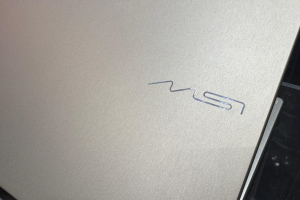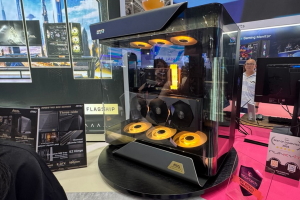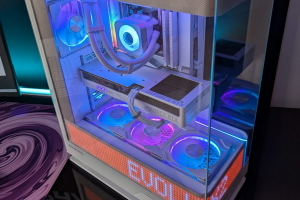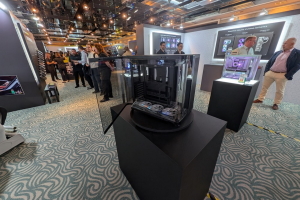Phenom II X6: cpu desktop a 6 core anche da AMD

Compatibili con le piattaforme socket AM3 e socket AM2+ già presenti sul mercato, i nuovi processori Phenom II X6 di AMD si propongono come valide alternative ai processori Intel Core i7 in quegli scenari d'uso nei quali le applicazioni beneficiano della presenza di più core
di Paolo Corsini pubblicato il 27 Aprile 2010 nel canale ProcessoriIntelAMD
Configurazione di test
Nel corso dei test abbiamo cercato di raccogliere differenti tipologie di applicazioni, così da simulare i principali scenari di utilizzo di un processore moderno dotato di architettura multicore. Molte applicazioni non permettono di sfruttare contemporaneamente e al 100% tutti i core a disposizione del sistema: solo in limitati scenari di utilizzo è possibile beneficare della presenza di più di 4 core, o della possibilità per un processore di gestire più di 4 threads in parallelo a prescindere dal numero dei core. Nell'analisi dei risultati bisognerà quindi tenere in debita considerazione la tipologia di applicazione che è stata eseguita e la sua scalabilità al crescere del numero dei threads che lo specifico processore in dotazione può gestire contemporaneamente.
Nei grafici sono stati inseriti i risultati dei processori Phenom II X6 1090T e 1055T ottenuti sia con piattaforma AMD 790FX sia con la più recente AMD 890FX; per entrambe le cpu e le piattaforme la tecnologia Turbo Core è stata attivata con impostazioni di default.
Questi i componenti utilizzati nei test:
- Scheda madre Socket 1156 LGA: Intel DH55TC, chipset Intel H55
- Scheda madre Socket 1156 LGA: Intel DP55KG, chipset Intel P55
- Scheda madre Socket 1366 LGA: Intel DX58SO Extreme Series, chipset Intel X58
- Scheda madre Socket AM3: Asus M4A79T Deluxe, chipset AMD 790FX
- Scheda madre Socket AM3: ASUS CrossHair IV Formula, chipset AMD 890FX
- Memoria sistema: Corsair DDR3 1333 Mhz 8-8-8-20 2T; 2 moduli da 2 Gbytes ciascuno (3 moduli per la piattaforma Socket 1366 LGA)
- Hard disk: Maxtor DiamondMax 23; 500 Gbytes SATA, 7.200 rpm
- Scheda video: ATI Radeon HD 5870
- Sistema operativo: Windows Vista 64bit, service pack 2
- Driver Video: Catalyst 10.2
Processori:
- AMD Phenom II X6 1090T (3,2 GHz): Socket AM3, cache L3 6 Mbytes; memoria 2x2 Gbytes DDR3-1333
- AMD Phenom II X6 1055T (2,8 GHz): Socket AM3, cache L3 6 Mbytes; memoria 2x2 Gbytes DDR3-1333
- AMD Phenom II X4 965 (3,4 GHz): Socket AM3, cache L3 6 Mbytes; memoria 2x2 Gbytes DDR3-1333
- AMD Phenom II X4 955 (3,2 GHz): Socket AM3, cache L3 6 Mbytes; memoria 2x2 Gbytes DDR3-1333
- AMD Phenom II X4 945 (3 GHz): Socket AM3, cache L3 6 Mbytes; memoria 2x2 Gbytes DDR3-1333
- AMD Phenom II X4 925 (2,8 GHz): Socket AM3, cache L3 6 Mbytes; memoria 2x2 Gbytes DDR3-1333
- AMD Athlon II X4 635 (2,9 GHz): Socket AM3, cache L3 assente; memoria 2x2 Gbytes DDR3-1333
- AMD Athlon II X4 630 (2,8 GHz): Socket AM3, cache L3 assente; memoria 2x2 Gbytes DDR3-1333
- AMD Athlon II X4 620 (2,6 GHz): Socket AM3, cache L3 assente; memoria 2x2 Gbytes DDR3-1333
- AMD Phenom II X2 555 (3,2 GHz): Socket AM3, cache L3 6 Mbytes; memoria 2x2 Gbytes DDR3-1333
- AMD Phenom II X2 550 (3,1 GHz): Socket AM3, cache L3 6 Mbytes; memoria 2x2 Gbytes DDR3-1333
- AMD Phenom II X2 545 (3 GHz): Socket AM3, cache L3 6 Mbytes; memoria 2x2 Gbytes DDR3-1333
- Intel Core i7 980X (3,33 GHz): Socket 1366 LGA, cache L3 12 Mbytes; memoria 3x2 Gbytes DDR3-1333
- Intel Core i7 975 (3,33 GHz): Socket 1366 LGA, cache L3 8 Mbytes; memoria 3x2 Gbytes DDR3-1333
- Intel Core i7 960 (3,2 GHz): Socket 1366 LGA, cache L3 8 Mbytes; memoria 3x2 Gbytes DDR3-1066
- Intel Core i7 950 (3,06 GHz): Socket 1366 LGA, cache L3 8 Mbytes; memoria 3x2 Gbytes DDR3-1066
- Intel Core i7 940 (2,93 GHz): Socket 1366 LGA, cache L3 8 Mbytes; memoria 3x2 Gbytes DDR3-1066
- Intel Core i7 930 (2,8 GHz): Socket 1366 LGA, cache L3 8 Mbytes; memoria 3x2 Gbytes DDR3-1066
- Intel Core i7 920 (2,67 GHz): Socket 1366 LGA, cache L3 8 Mbytes; memoria 3x2 Gbytes DDR3-1066
- Intel Core i7 870 (2,93 GHz): Socket 1156 LGA, cache L3 8 Mbytes; memoria 2x2 Gbytes DDR3-1333
- Intel Core i7 860 (2,8 GHz): Socket 1156 LGA, cache L3 8 Mbytes; memoria 2x2 Gbytes DDR3-1333
- Intel Core i5 750 (2,66 GHz): Socket 1156 LGA, cache L3 8 Mbytes; memoria 2x2 Gbytes DDR3-1333
- Intel Core i5 661 (2,66 GHz): Socket 1156 LGA, cache L3 4 Mbytes; memoria 2x2 Gbytes DDR3-1333
Queste le applicazioni utilizzate nei test:
- Povray 3.7 beta 35a - 64bit
rendering benchmark - Cinebench 11.5 - 64bit
rendering x CPU - 3ds Max 2010
rendering primo frame scena max_benchmark 640x480 pixel, da MaxScaline - Blender 2.48
render flyingsquirrerblend - Euler 3D
benchmark (in Hz)
- AutoMVK 0.98.4
conversione x264 kitesurfing.avi; 2 pass balanced quality; bilinear resize soft - Mainconcept Reference Encoder and Decoder 1.6.1
Codec: H.264/AVC Pro; Profile: High; video Intel_2007_partnership_edit.mpeg; 1920x1080 - x264 HD benchmark 3.13
first pass
second pass - Windows Live Movie Maker
conversione for portable device; video Intel_2007_partnership_edit.mpeg; 1920x1080 - ProShow Gold 4.1
conversione 29 immagini in video mpeg2 HD - HandBrake
conversione con preset "Iphone e Ipod Touch"
- Unreal Tournament 3 - no AA anis 16x; ShangriLa
1280x1024
1600x1200 - Half Life 2 Episode 2 - AA 8xMSAA anis 16x
1280x1024
1600x1200 - Crysis (DX10 - very high - anis 16x aa4x)
1280x1024
1600x1200 - Far Cry 2 - aa4x very high DX10
1280x1024
1600x1200 - World in Conflict
1280x1024
1600x1200 - HAWX DX 10.1 - AA4x (tutto alto, SSAO basso)
1280x1024
1600x1200 - Stalker (DX11) - day, preset medium
1280x1024
1600x1200
- Winrar 3.90 beta 2 x64
test integrato - 7-Zip 9.06 beta x64
compressione
decompressione







 DJI Mavic 4 Pro: sblocca un nuovo livello per le riprese aeree
DJI Mavic 4 Pro: sblocca un nuovo livello per le riprese aeree Idrogeno verde in Europa: nuovi studi prevedono costi ben superiori alle aspettative
Idrogeno verde in Europa: nuovi studi prevedono costi ben superiori alle aspettative Mario Kart World lancia Switch 2: la magia Nintendo ora in 4K
Mario Kart World lancia Switch 2: la magia Nintendo ora in 4K Scambio di chiavi quantistico via satellite: Colt, Honeywell e Nokia ci provano. Ma ha senso?
Scambio di chiavi quantistico via satellite: Colt, Honeywell e Nokia ci provano. Ma ha senso? HONOR 400 è un successo! Forte slancio nelle vendite con un +400%
HONOR 400 è un successo! Forte slancio nelle vendite con un +400% Redmi Pad 2, i nuovi tablet Xiaomi costano a partire da 200 euro: ecco le novità
Redmi Pad 2, i nuovi tablet Xiaomi costano a partire da 200 euro: ecco le novità All'aeroporto di Fiumicino il più grande sistema di accumulo italiano con batterie EV usate
All'aeroporto di Fiumicino il più grande sistema di accumulo italiano con batterie EV usate HONOR 400 vs HONOR 400 Pro: tutte le differenze, le specifiche e i punti di forza a confronto
HONOR 400 vs HONOR 400 Pro: tutte le differenze, le specifiche e i punti di forza a confronto Nintendo Switch 2 debutta oggi nei negozi! Prezzo e dettagli
Nintendo Switch 2 debutta oggi nei negozi! Prezzo e dettagli Samsung Galaxy S25 Edge è disponibile in Italia! Lo smartphone sottile, potente e intelligente come mai prima
Samsung Galaxy S25 Edge è disponibile in Italia! Lo smartphone sottile, potente e intelligente come mai prima  Nothing presenterà le sue prime cuffie over-ear il prossimo 1° luglio insieme a Phone(3)
Nothing presenterà le sue prime cuffie over-ear il prossimo 1° luglio insieme a Phone(3)  Le nuove soluzioni Lenovo per lo storage e oltre: ThinkAgile, ThinkSystem e gli AI Starter Kit
Le nuove soluzioni Lenovo per lo storage e oltre: ThinkAgile, ThinkSystem e gli AI Starter Kit Netatmo presenta la nuova Stazione Meteo ORIGINAL: aggiornata, potenziata con misurazione pollini e UV
Netatmo presenta la nuova Stazione Meteo ORIGINAL: aggiornata, potenziata con misurazione pollini e UV Cybersecurity: Fortinet rende disponibile Workspace Security Suite e aggiorna FortiDLP
Cybersecurity: Fortinet rende disponibile Workspace Security Suite e aggiorna FortiDLP Netatmo Stazione Meteo ORIGINAL: il ritorno di un’icona, più smart che mai
Netatmo Stazione Meteo ORIGINAL: il ritorno di un’icona, più smart che mai Il meglio dello State of Play, dal nuovo titolo di Suda51 alla collezione più completa di Mortal Kombat
Il meglio dello State of Play, dal nuovo titolo di Suda51 alla collezione più completa di Mortal Kombat Homematic IP: nuova app per ottimizzare i flussi energetici della casa
Homematic IP: nuova app per ottimizzare i flussi energetici della casa


















